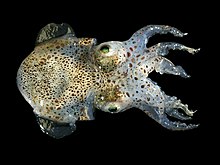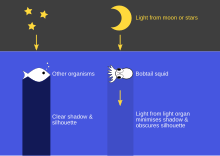Bobtail squid
| Bobtail squid | |
|---|---|

| |
| Sepiola atlantica | |
| Scientific classification | |
| Domain: | Eukaryota |
| Kingdom: | Animalia |
| Phylum: | Mollusca |
| Class: | Cephalopoda |
| Superorder: | Decapodiformes |
| Order: | Sepiolida Fioroni,1981 |
| Families | |
Bobtail squid(order Sepiolida)[1]are a group ofcephalopodsclosely related tocuttlefish.Bobtail squid tend to have a roundermantlethan cuttlefish and have nocuttlebone.They have eight suckered arms and two tentacles and are generally quite small (typical male mantle length being between 1 and 8 cm (0.39 and 3.15 in)).[2]
Sepiolids live in shallowcoastalwaters of thePacific Oceanand some parts of theIndian OceanandAtlantic Oceanas well as in shallow waters on the west coast of theCape Peninsulaoff South Africa. Like cuttlefish, they can swim by either using thefinson their mantle or by jet propulsion. They are also known as "dumpling squid" (owing to their rounded mantle) or "stubby squid".
Light organ
[edit]
Bobtail squid have asymbioticrelationship withbioluminescentbacteria(Aliivibrio fischeri), which inhabit a special light organ in the squid's mantle. The luminescent properties of the bacteria regulate gene expression in the light organ.[3]The bacteria are fed a sugar and amino acid solution by the squid and in return hide the squid'ssilhouettewhen viewed from below by matching the amount of light hitting the top of the mantle. This method ofcounter-illuminationis an example of animalcamouflage.
The organ contains filters which may alter thewavelengthof luminescence closer to that of downwellingmoonlightandstarlight;alenswithbiochemicalsimilarities to the squid's eye to diffuse the bacterial luminescence; and areflectorwhich directs the lightventrally.[2]
Reproduction
[edit]Sepiolida areiteroparousand a female might lay several clutches, each of 1–400 eggs (dependent onspecies), over her estimated one-year-long lifetime.[2]The eggs are covered with sand and left without parental care.[2]Symbiosis withA. fischerifrom the surrounding seawater is initiated immediately upon hatching, and the bacteria'scolonisationof thejuvenilelight-organ inducesmorphologicalchanges in the squid that lead tomaturity.[2]
Classification
[edit]
About seventy species are known. Sepiolid taxonomy within thecoleoidcephalopods is currently controversial, thus their position is subject to future change.[2]
- ClassCephalopoda
- SubclassNautiloidea:nautilus
- SubclassColeoidea:squid,octopus,cuttlefish
- SuperorderDecapodiformes
- OrderSpirulida:ram's horn squid
- OrderSepiida:cuttlefish
- Order Sepiolida:bobtail squid
- FamilyIdiosepiidae
- FamilySepiolidae
- OrderTeuthida:squid
- Superorder †Palaeoteuthomorpha
- Order †Boletzkyida
- SuperorderOctopodiformes
- SuperorderDecapodiformes
References
[edit]- ^Gustavo Sanchez; Jeffrey Jolly; Amanda Reid; Chikatoshi Sugimoto; Chika Azama; Ferdinand Marlétaz; Oleg Simakov; Daniel S. Rokhsar (2019-12-11)."New bobtail squid (Sepiolidae: Sepiolinae) from the Ryukyu islands revealed by molecular and morphological analysis".Communications Biology.2(465): 465.doi:10.1038/s42003-019-0661-6.PMC6906322.PMID31840110.
- ^abcdefMcFall-Ngai, M.J. (1999). "Consequences of evolving with bacterial symbionts: Insights from the Squid-Vibrio Associations".Annual Review of Ecology and Systematics.30:235–256.doi:10.1146/annurev.ecolsys.30.1.235.
- ^Peyer, Suzanne M.; Pankey, M. Sabrina; Oakley, Todd H.; McFall-Ngai, Margaret J. (February 2014)."Eye-specification genes in the bacterial light organ of the bobtail squid Euprymna scolopes, and their expression in response to symbiont cues".Mechanisms of Development.131:111–126.doi:10.1016/j.mod.2013.09.004.ISSN0925-4773.PMC4000693.PMID24157521.
